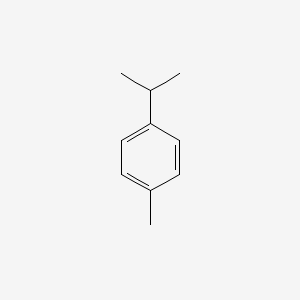| MeSH term | MeSH ID | Detail |
|---|---|---|
| Carbon Tetrachloride Poisoning | D002252 | 12 associated lipids |
| Chemical and Drug Induced Liver Injury | D056486 | 39 associated lipids |
| Dermatomycoses | D003881 | 17 associated lipids |
p-Cymene
P-cymene is a lipid of Prenol Lipids (PR) class. P-cymene is associated with abnormalities such as Abnormal shape. The involved functions are known as Binding (Molecular Function), inhibitors and Oxidation. P-cymene often locates in Cell membrane. The associated genes with p-Cymene are Chromatin, Homologous Gene and ethylbenzene dehydrogenase. The related lipids are Steroids.
Cross Reference
Introduction
To understand associated biological information of p-Cymene, we collected biological information of abnormalities, associated pathways, cellular/molecular locations, biological functions, related genes/proteins, lipids and common seen animal/experimental models with organized paragraphs from literatures.
What diseases are associated with p-Cymene?
p-Cymene is suspected in Abnormal shape and other diseases in descending order of the highest number of associated sentences.
Related references are mostly published in these journals:
| Disease | Cross reference | Weighted score | Related literature |
|---|
Possible diseases from mapped MeSH terms on references
We collected disease MeSH terms mapped to the references associated with p-Cymene
PubChem Associated disorders and diseases
What pathways are associated with p-Cymene
There are no associated biomedical information in the current reference collection.
PubChem Biomolecular Interactions and Pathways
Link to PubChem Biomolecular Interactions and PathwaysWhat cellular locations are associated with p-Cymene?
Visualization in cellular structure
Associated locations are in red color. Not associated locations are in black.
Related references are published most in these journals:
| Location | Cross reference | Weighted score | Related literatures |
|---|
What functions are associated with p-Cymene?
Related references are published most in these journals:
| Function | Cross reference | Weighted score | Related literatures |
|---|
What lipids are associated with p-Cymene?
Related references are published most in these journals:
| Lipid concept | Cross reference | Weighted score | Related literatures |
|---|
What genes are associated with p-Cymene?
Related references are published most in these journals:
| Gene | Cross reference | Weighted score | Related literatures |
|---|
What common seen animal models are associated with p-Cymene?
There are no associated biomedical information in the current reference collection.
NCBI Entrez Crosslinks
All references with p-Cymene
Download all related citations| Authors | Title | Published | Journal | PubMed Link |
|---|---|---|---|---|
| Rajput SB and Karuppayil SM | Small molecules inhibit growth, viability and ergosterol biosynthesis in Candida albicans. | 2013 | Springerplus | pmid:23449869 |
| Ferraz RP et al. | Cytotoxic effect of leaf essential oil of Lippia gracilis Schauer (Verbenaceae). | 2013 | Phytomedicine | pmid:23453306 |
| Chen Y et al. | A ruthenium(II) arene complex showing emission enhancement and photocleavage activity towards DNA from singlet and triplet excited states respectively. | 2013 | Dalton Trans | pmid:23459918 |
| de Lira Mota KS et al. | Antifungal activity of Thymus vulgaris L. essential oil and its constituent phytochemicals against Rhizopus oryzae: interaction with ergosterol. | 2012 | Molecules | pmid:23519243 |
| Adeniyi AA and Ajibade PA | Comparing the suitability of autodock, gold and glide for the docking and predicting the possible targets of Ru(II)-based complexes as anticancer agents. | 2013 | Molecules | pmid:23529035 |
| Herzi N et al. | Comparison between supercritical CO2 extraction and hydrodistillation for two species of eucalyptus: yield, chemical composition, and antioxidant activity. | 2013 | J. Food Sci. | pmid:23551200 |
| Matan N et al. | Enhanced inhibition of Aspergillus niger on sedge (Lepironia articulata) treated with heat-cured lime oil. | 2013 | J. Appl. Microbiol. | pmid:23617888 |
| Enyedy EA et al. | Solution equilibria of anticancer ruthenium(II)-(η(6)-p-cymene)-hydroxy(thio)pyr(id)one complexes: impact of sulfur vs. oxygen donor systems on the speciation and bioactivity. | 2013 | J. Inorg. Biochem. | pmid:23721887 |
| Quintans-Júnior L et al. | Antinociceptive Activity and Redox Profile of the Monoterpenes (+)-Camphene, p-Cymene, and Geranyl Acetate in Experimental Models. | 2013 | ISRN Toxicol | pmid:23724298 |
| Busto N et al. | Anticancer activity and DNA binding of a bifunctional Ru(II) arene aqua-complex with the 2,4-diamino-6-(2-pyridyl)-1,3,5-triazine ligand. | 2013 | Inorg Chem | pmid:23957818 |
| Zhang L et al. | Ru-catalyzed 1,4-addition of arylboronic acids to acrylic acid derivatives in the presence of phenols. | 2013 | Chem. Commun. (Camb.) | pmid:23961538 |
| pmid:24076562 | ||||
| Chen L et al. | Protective effect of p-cymene on lipopolysaccharide-induced acute lung injury in mice. | 2014 | Inflammation | pmid:24085645 |
| Lucia A et al. | Knockdown and larvicidal activity of six monoterpenes against Aedes aegypti (Diptera: Culicidae) and their structure-activity relationships. | 2013 | Parasitol. Res. | pmid:24100604 |
| Alarcón P et al. | Reversible addition of the OH radical to p-cymene in the gas phase: kinetic analysis assuming formation of a single adduct. Part 1. | 2013 | Phys Chem Chem Phys | pmid:24153351 |
| Ganeshpandian M et al. | New ruthenium(II) arene complexes of anthracenyl-appended diazacycloalkanes: effect of ligand intercalation and hydrophobicity on DNA and protein binding and cleavage and cytotoxicity. | 2014 | Dalton Trans | pmid:24177707 |
| Dayan S et al. | Synthesis of imine and reduced imine compounds containing aromatic sulfonamide: use as catalyst for in situ generation of ruthenium catalysts in transfer hydrogenation of acetophenone derivatives. | 2014 | Spectrochim Acta A Mol Biomol Spectrosc | pmid:24184620 |
| Azam M et al. | Comparative analysis of flower volatiles from nine citrus at three blooming stages. | 2013 | Int J Mol Sci | pmid:24232454 |
| Andreani S et al. | Chemical variability and antioxidant activity of Limbarda crithmoides L. essential oil from Corsica. | 2013 | Chem. Biodivers. | pmid:24243615 |
| Béjaoui A et al. | Essential oil composition and antibacterial activity of Origanum vulgare subsp. glandulosum Desf. at different phenological stages. | 2013 | J Med Food | pmid:24320986 |
